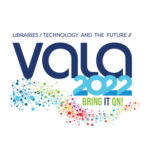Working with spaghetti: integrating everything with everything else
 VALA2022 CC2 TABLE 2
VALA2022 CC2 TABLE 2
Wednesday 15 June 2022, 09.15-09.45 and 09.55-10.25
Alan Manifold
- Digital Preservation Manager
- State Library of Victoria
Please tag your comments, tweets, and blog posts about this session: #vala2022 #cc2
Abstract
We’ve all seen so-called “spaghetti diagrams” that show the convoluted and intertwined connections between systems. We’d love it if this wasn’t necessary, but that’s not the reality we live in, is it? We want all our systems to be connected whenever it makes sense and sometimes when it doesn’t, so spaghetti is our way of life.
Interconnections come in lots of varieties, though. They can require a simple click of a checkbox, the installation and configuration of a third-party “wedge” product, or writing code to take advantage of an API (or even writing an API!). Starting with some examples of interconnections created at State Library Victoria, we’ll have a conversation about how to determine when interconnection is called for, how much effort is too much, and what constitutes success. Come prepared with your own examples of interconnections successful and less so.
Biography
 Alan Manifold has more than forty years’ experience in library automation in the US and Australia, and now serves as Digital Preservation Manager at State Library Victoria. He led development of a home-grown integrated library system, and has worked extensively with NOTIS, Voyager, Aleph, Primo, ArchivesSpace, and Alma. In 2015, Australia awarded him a Distinguished Talent visa in library automation. He has served on NOTIS, Endeavor, and Ex Libris User groups, and on the VALA Committee. He has integrated several systems that had no real business being integrated with each other, but has no regrets!
Alan Manifold has more than forty years’ experience in library automation in the US and Australia, and now serves as Digital Preservation Manager at State Library Victoria. He led development of a home-grown integrated library system, and has worked extensively with NOTIS, Voyager, Aleph, Primo, ArchivesSpace, and Alma. In 2015, Australia awarded him a Distinguished Talent visa in library automation. He has served on NOTIS, Endeavor, and Ex Libris User groups, and on the VALA Committee. He has integrated several systems that had no real business being integrated with each other, but has no regrets!
This work is licensed under a Creative Commons Attribution-NonCommercial License.
